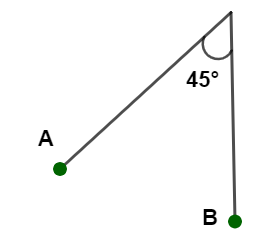
The bob A of a simple pendulum is released when the string makes an angle of ${45^ \circ }\] with the vertical. It hits another bob B of the same material and same mass kept at rest on the table. If the collision is elastic:

A. both A and B rise to the same height
B. both A and B come to rest at B
C. both A and B move with the velocity of A
D. A comes to rest and B moves with the velocity of A
Answer
223.2k+ views
Hint: A collision between two bodies in physics is referred to as an elastic collision if their combined kinetic energy stays constant. There is no net conversion of kinetic energy into other forms, such as heat, noise, or potential energy, in an ideal, fully elastic collision. According to the law of conservation of momentum, a system's overall momentum remains constant in the absence of an external force.
Formula:
$e =\dfrac{\text{Speed by which the objects separate}}{\text{Speed in which the objects approach}}$
Complete step by step solution:
Let $u$ and $v$ represent the initial and final velocities. After a collision, the velocities of the two spheres switch due to their same masses and the elastic impact. By the law of conservation of momentum,
$m{u_1} = m{v_1} + m{v_2}$
Rewriting the above equation,
${v_1} + {v_2} = {u_1}$.............(1)
Now, equating the value of ‘e’ to 1 and the result is,
$e = \dfrac{{{v_2} - {v_1}}}{{{u_1}}} \\
\Rightarrow 1 = \dfrac{{{v_2} - {v_1}}}{{{u_1}}} \\ $
Rewriting the above equation,
${v_2} - {v_1} = {u_1}$...........(2)
By the equations (1) and (2), we get the values
${v_1} = 0 \\
\Rightarrow {v_2} = {u_1} $
Therefore, A comes to rest and B will move with the velocity of A.
Hence, option D is correct.
Note: As long as the amplitude is modest, the period of oscillation of a simple pendulum with constant length is independent of the amplitude. A mass of no size fastened to a massless thread serves as a rudimentary pendulum's representation. An actual item that is moving about a point other than its centre of gravity is shown by a compound pendulum.
Formula:
$e =\dfrac{\text{Speed by which the objects separate}}{\text{Speed in which the objects approach}}$
Complete step by step solution:
Let $u$ and $v$ represent the initial and final velocities. After a collision, the velocities of the two spheres switch due to their same masses and the elastic impact. By the law of conservation of momentum,
$m{u_1} = m{v_1} + m{v_2}$
Rewriting the above equation,
${v_1} + {v_2} = {u_1}$.............(1)
Now, equating the value of ‘e’ to 1 and the result is,
$e = \dfrac{{{v_2} - {v_1}}}{{{u_1}}} \\
\Rightarrow 1 = \dfrac{{{v_2} - {v_1}}}{{{u_1}}} \\ $
Rewriting the above equation,
${v_2} - {v_1} = {u_1}$...........(2)
By the equations (1) and (2), we get the values
${v_1} = 0 \\
\Rightarrow {v_2} = {u_1} $
Therefore, A comes to rest and B will move with the velocity of A.
Hence, option D is correct.
Note: As long as the amplitude is modest, the period of oscillation of a simple pendulum with constant length is independent of the amplitude. A mass of no size fastened to a massless thread serves as a rudimentary pendulum's representation. An actual item that is moving about a point other than its centre of gravity is shown by a compound pendulum.
Recently Updated Pages
JEE General Topics in Chemistry Important Concepts and Tips

JEE Extractive Metallurgy Important Concepts and Tips for Exam Preparation

JEE Atomic Structure and Chemical Bonding important Concepts and Tips

JEE Amino Acids and Peptides Important Concepts and Tips for Exam Preparation

Electricity and Magnetism Explained: Key Concepts & Applications

JEE Energetics Important Concepts and Tips for Exam Preparation

Trending doubts
JEE Main 2026: City Intimation Slip Expected Soon, Application Form Closed, Exam Dates, Syllabus & Eligibility

JEE Main 2026 Application Login: Direct Link, Registration, Form Fill, and Steps

Understanding the Angle of Deviation in a Prism

How to Convert a Galvanometer into an Ammeter or Voltmeter

Ideal and Non-Ideal Solutions Explained for Class 12 Chemistry

Hybridisation in Chemistry – Concept, Types & Applications

Other Pages
JEE Advanced Marks vs Ranks 2025: Understanding Category-wise Qualifying Marks and Previous Year Cut-offs

Mechanical Properties of Fluids Class 11 Physics Chapter 9 CBSE Notes - 2025-26

Units And Measurements Class 11 Physics Chapter 1 CBSE Notes - 2025-26

Degree of Dissociation: Meaning, Formula, Calculation & Uses

Understanding Electromagnetic Waves and Their Importance

Understanding Atomic Structure for Beginners




